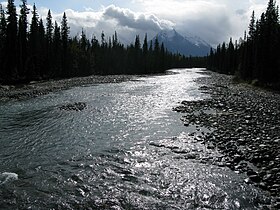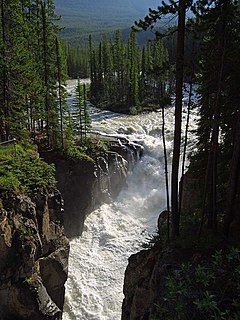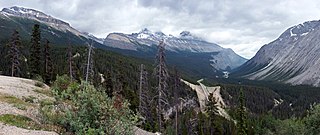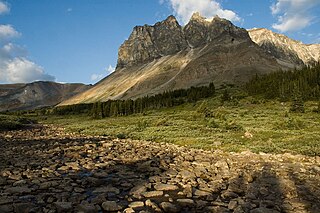| Whirlpool River | |
|---|---|
The Whirlpool River from Alberta Highway 93A | |
| Country | |
| Physical characteristics | |
| Main source | Athabasca Pass 1,704 m (5,591 ft) 52°23′46″N118°12′15″W / 52.39611°N 118.20417°W |
| River mouth | Athabasca River 1,121 m (3,678 ft) 52°44′06″N117°57′15″W / 52.73500°N 117.95417°W Coordinates: 52°44′06″N117°57′15″W / 52.73500°N 117.95417°W |

The Whirlpool River is a short river in Jasper National Park, Alberta, Canada. It is an early tributary of the Athabasca River.

A river is a natural flowing watercourse, usually freshwater, flowing towards an ocean, sea, lake or another river. In some cases a river flows into the ground and becomes dry at the end of its course without reaching another body of water. Small rivers can be referred to using names such as stream, creek, brook, rivulet, and rill. There are no official definitions for the generic term river as applied to geographic features, although in some countries or communities a stream is defined by its size. Many names for small rivers are specific to geographic location; examples are "run" in some parts of the United States, "burn" in Scotland and northeast England, and "beck" in northern England. Sometimes a river is defined as being larger than a creek, but not always: the language is vague.
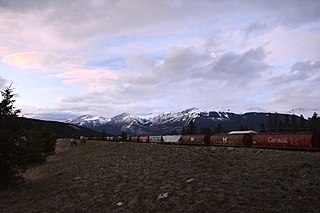
Jasper National Park is the largest national park in the Canadian Rockies, spanning 11,000 km2 (4,200 sq mi). It is located in the province of Alberta, north of Banff National Park and west of Edmonton. The park includes the glaciers of the Columbia Icefield, hot springs, lakes, waterfalls and mountains.

Alberta is a western province of Canada. With an estimated population of 4,067,175 as of 2016 census, it is Canada's fourth most populous province and the most populous of Canada's three prairie provinces. Its area is about 660,000 square kilometres (250,000 sq mi). Alberta and its neighbour Saskatchewan were districts of the Northwest Territories until they were established as provinces on September 1, 1905. The premier has been Rachel Notley since 2015.
Contents
The Whirlpool is formed in Athabasca Pass, collecting meltwater from the Hooker Icefield and the Mount Brown Icefield. It flows north, collecting the Middle Whirlpool River before passing under Alberta Highway 93A and flowing into the Athabasca River south of Jasper. The Moab Lake Road parallels the Whirlpool near its confluence with the Athabasca River.

Athabasca Pass is a high mountain pass in the Canadian Rockies. It is the headwaters of the Whirlpool River, a tributary of the Athabasca River. In fur-trade days it connected Jasper House on the Athabasca River with Boat Encampment on the Columbia River.

Jasper is a specialized municipality in western Alberta, Canada. It is the commercial centre of Jasper National Park, located in the Canadian Rockies within the Athabasca River valley. Jasper is approximately 362 kilometres (225 mi) west of Edmonton and 290 kilometres (180 mi) north of Banff, Alberta, at the intersection of Highway 16 and Highway 93.

In geography, a confluence occurs where two or more flowing bodies of water join together to form a single channel. A confluence can occur in several configurations: at the point where a tributary joins a larger river ; or where two streams meet to become the source of a river of a new name ; or where two separated channels of a river rejoin at the downstream end.
The Whirlpool was named by Sir James Hector in 1859. He noted the presence of many eddies in the river. [1]
